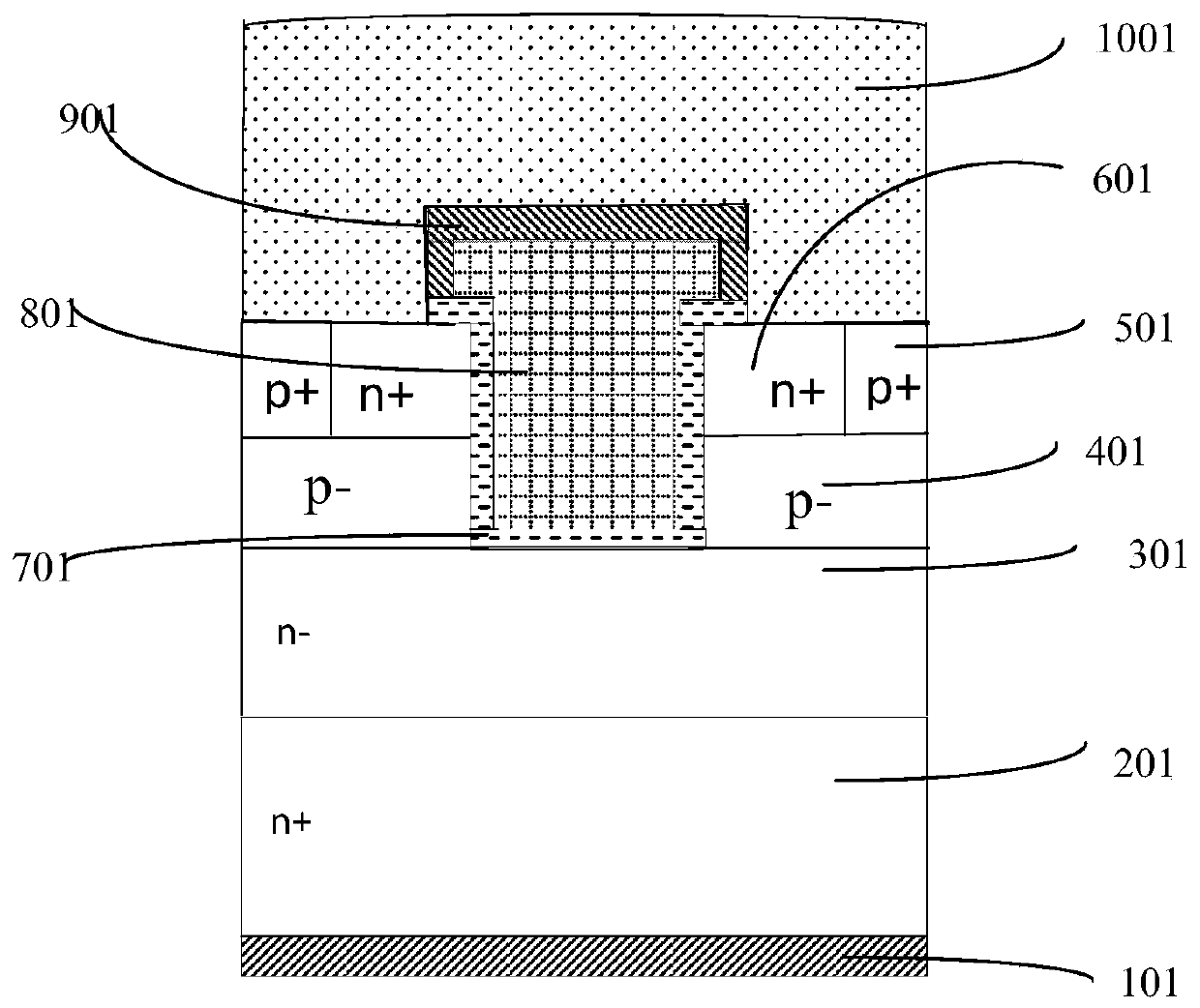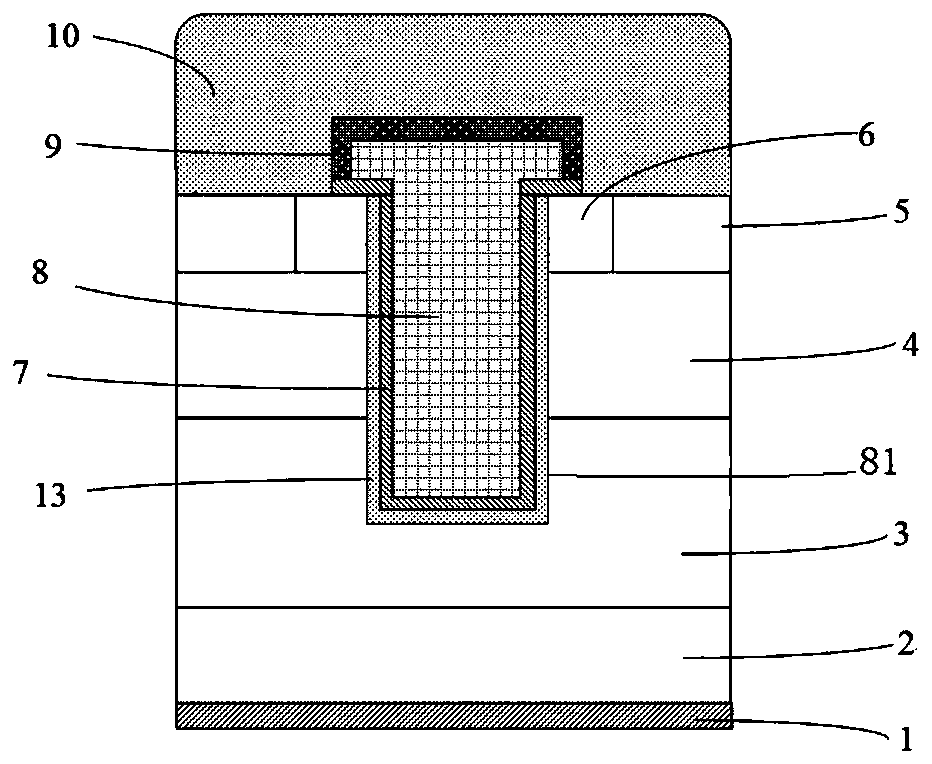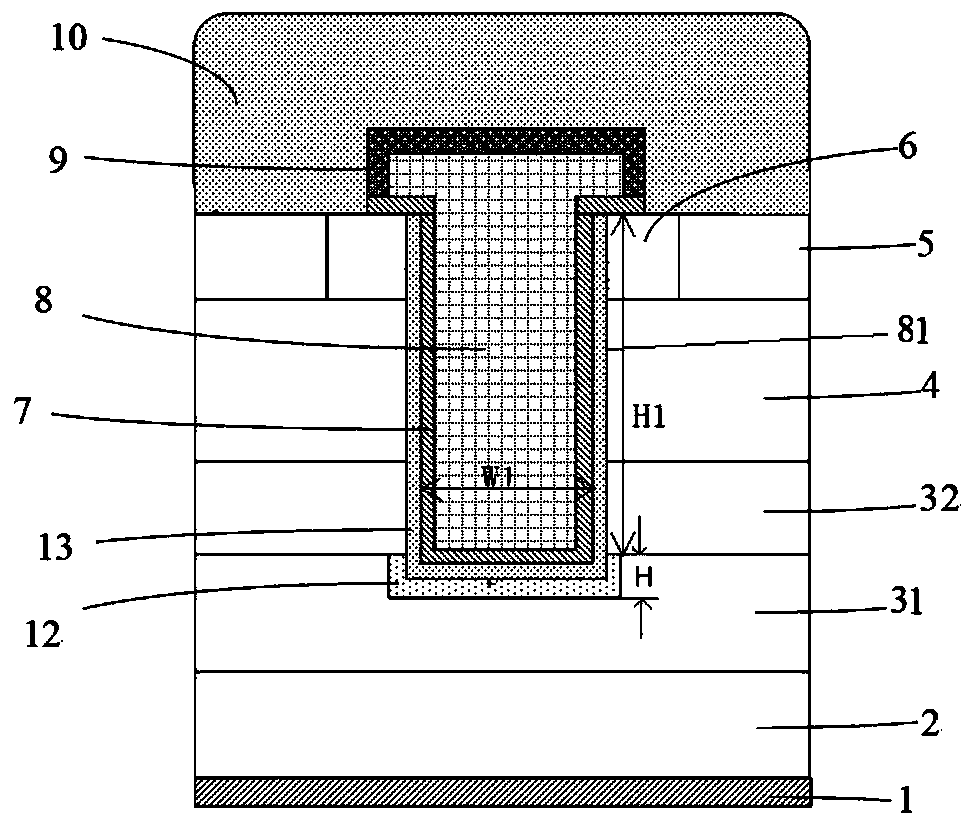Silicon carbide MOSFET and preparation method thereof
A technology of silicon carbide and silicon carbide substrates, applied in semiconductor/solid-state device manufacturing, semiconductor devices, electrical components, etc., can solve problems such as increasing field strength, SiC MOSFET needs to be improved, and low electron mobility in the inversion layer
- Summary
- Abstract
- Description
- Claims
- Application Information
AI Technical Summary
Problems solved by technology
Method used
Image
Examples
Embodiment 1
[0049] Preparation methods include:
[0050] Step 1: On the heavily doped n+ type SIC substrate 2, the first epitaxial layer 31 of n-type SIC is epitaxially formed by PECVD; the doping concentration of the first epitaxial layer 31 is 1×10 15 cm -3 , the thickness is 10 microns, the doping impurity is nitrogen (N), and the structural diagram is shown in Figure 5 .
[0051] Step 2: Etching the n-type first epitaxial layer 31 to form a step profile, the etching depth is 0.1 micron, see the structure schematic diagram Figure 6 .
[0052] Step 3: Epitaxially form a heavily doped p+ epitaxial layer 121 on the etched n-type first epitaxial layer 31 and perform etching to form the p+ heavily doped region 12; the p+ heavily doped region 12 The doping concentration is 1×10 16 cm -3 , the doping impurity is aluminum (Al), and the thickness is 1 micron; Figure 7 , Figure 8 shown.
[0053] Step 4: Continue epitaxially forming an n-lightly doped second epitaxial layer 32 on the...
Embodiment 2
[0062] Preparation methods include:
[0063] Step 1: On the heavily doped n+ type SIC substrate 2, an n-type SIC epitaxial layer 3 is formed by MOCVD epitaxy; the doping concentration of the epitaxial layer 3 is 5×10 15 cm -3 , the thickness is 15 microns, the dopant impurity is nitrogen (N), and the structural diagram is shown in Figure 4 .
[0064] Step 2: Epitaxially form a p-type epitaxial layer 4 on the n-type epitaxial layer 3; the doping concentration of the p-type SIC lightly doped epitaxial layer 4 is 5×10 13 cm -3 , the doping impurity is aluminum (Al), and the thickness is 2.5 microns; if Figure 4 shown;
[0065] Step 3: forming n+ source region 6 and p+ contact region 5 on epitaxial layer 4 by photolithography and implantation; the doping concentration of source region 6 is 1×10 15 cm -3 , the doping concentration of the contact region 5 is 5×10 15 cm -3 ; and carry out high temperature annealing after implantation, the annealing temperature is between 1...
Embodiment 3
[0072] Preparation methods include:
[0073] Step 1: On the heavily doped n+ type SIC substrate 2, the first epitaxial layer 31 of n-type SIC is epitaxially formed by PECVD; the doping concentration of the first epitaxial layer 31 is 1×10 16 cm -3 , the thickness is 15 microns, the dopant impurity is nitrogen (N), and the structural diagram is shown in Figure 5 .
[0074] Step 2: Etching the n-type first epitaxial layer 31 to form a step profile, the etching depth is 0.4 microns, see the structure schematic diagram Figure 6 .
[0075] Step 3: Epitaxially form a heavily doped p+ epitaxial layer 121 on the etched n-type first epitaxial layer 31 and perform etching to form the p+ heavily doped region 12; the p+ heavily doped region 12 The doping concentration is 1×10 17 cm -3 , the doping impurity is aluminum (Al), and the thickness is 2 microns; as Figure 7 , Figure 8 shown.
[0076] Step 4: Continue epitaxially forming an n-lightly doped second epitaxial layer 32 o...
PUM
| Property | Measurement | Unit |
|---|---|---|
| thickness | aaaaa | aaaaa |
| thickness | aaaaa | aaaaa |
| thickness | aaaaa | aaaaa |
Abstract
Description
Claims
Application Information
 Login to View More
Login to View More - R&D
- Intellectual Property
- Life Sciences
- Materials
- Tech Scout
- Unparalleled Data Quality
- Higher Quality Content
- 60% Fewer Hallucinations
Browse by: Latest US Patents, China's latest patents, Technical Efficacy Thesaurus, Application Domain, Technology Topic, Popular Technical Reports.
© 2025 PatSnap. All rights reserved.Legal|Privacy policy|Modern Slavery Act Transparency Statement|Sitemap|About US| Contact US: help@patsnap.com



